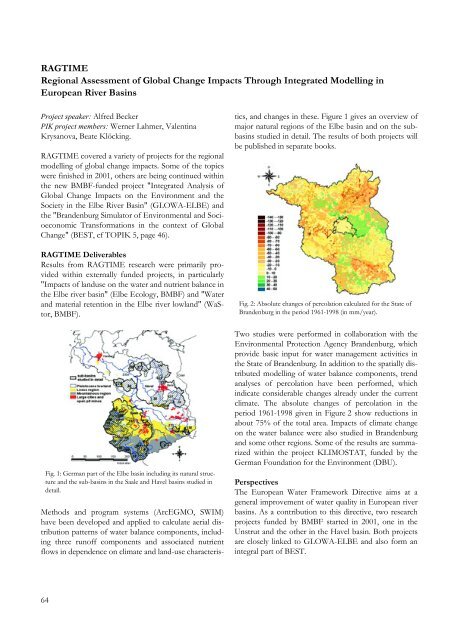PIK Biennial Report 2000-2001 - Potsdam Institute for Climate ...
PIK Biennial Report 2000-2001 - Potsdam Institute for Climate ...
PIK Biennial Report 2000-2001 - Potsdam Institute for Climate ...
Create successful ePaper yourself
Turn your PDF publications into a flip-book with our unique Google optimized e-Paper software.
RAGTIME<br />
Regional Assessment of Global Change Impacts Through Integrated Modelling in<br />
European River Basins<br />
Project speaker: Alfred Becker<br />
<strong>PIK</strong> project members: Werner Lahmer, Valentina<br />
Krysanova, Beate Klöcking.<br />
RAGTIME covered a variety of projects <strong>for</strong> the regional<br />
modelling of global change impacts. Some of the topics<br />
were finished in <strong>2001</strong>, others are being continued within<br />
the new BMBF-funded project "Integrated Analysis of<br />
Global Change Impacts on the Environment and the<br />
Society in the Elbe River Basin" (GLOWA-ELBE) and<br />
the "Brandenburg Simulator of Environmental and Socioeconomic<br />
Trans<strong>for</strong>mations in the context of Global<br />
Change" (BEST, cf TO<strong>PIK</strong> 5, page 46).<br />
RAGTIME Deliverables<br />
Results from RAGTIME research were primarily provided<br />
within externally funded projects, in particularly<br />
"Impacts of landuse on the water and nutrient balance in<br />
the Elbe river basin" (Elbe Ecology, BMBF) and "Water<br />
and material retention in the Elbe river lowland" (WaStor,<br />
BMBF).<br />
Fig. 1: German part of the Elbe basin including its natural structure<br />
and the sub-basins in the Saale and Havel basins studied in<br />
detail.<br />
Methods and program systems (ArcEGMO, SWIM)<br />
have been developed and applied to calculate aerial distribution<br />
patterns of water balance components, including<br />
three runoff components and associated nutrient<br />
flows in dependence on climate and land-use characteris-<br />
64<br />
tics, and changes in these. Figure 1 gives an overview of<br />
major natural regions of the Elbe basin and on the subbasins<br />
studied in detail. The results of both projects will<br />
be published in separate books.<br />
Fig. 2: Absolute changes of percolation calculated <strong>for</strong> the State of<br />
Brandenburg in the period 1961-1998 (in mm/year).<br />
Two studies were per<strong>for</strong>med in collaboration with the<br />
Environmental Protection Agency Brandenburg, which<br />
provide basic input <strong>for</strong> water management activities in<br />
the State of Brandenburg. In addition to the spatially distributed<br />
modelling of water balance components, trend<br />
analyses of percolation have been per<strong>for</strong>med, which<br />
indicate considerable changes already under the current<br />
climate. The absolute changes of percolation in the<br />
period 1961-1998 given in Figure 2 show reductions in<br />
about 75% of the total area. Impacts of climate change<br />
on the water balance were also studied in Brandenburg<br />
and some other regions. Some of the results are summarized<br />
within the project KLIMOSTAT, funded by the<br />
German Foundation <strong>for</strong> the Environment (DBU).<br />
Perspectives<br />
The European Water Framework Directive aims at a<br />
general improvement of water quality in European river<br />
basins. As a contribution to this directive, two research<br />
projects funded by BMBF started in <strong>2001</strong>, one in the<br />
Unstrut and the other in the Havel basin. Both projects<br />
are closely linked to GLOWA-ELBE and also <strong>for</strong>m an<br />
integral part of BEST.

















